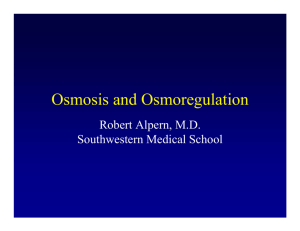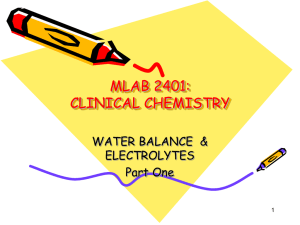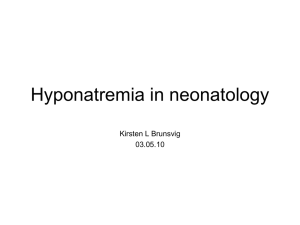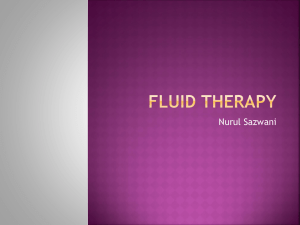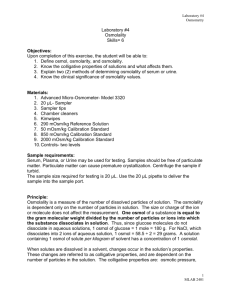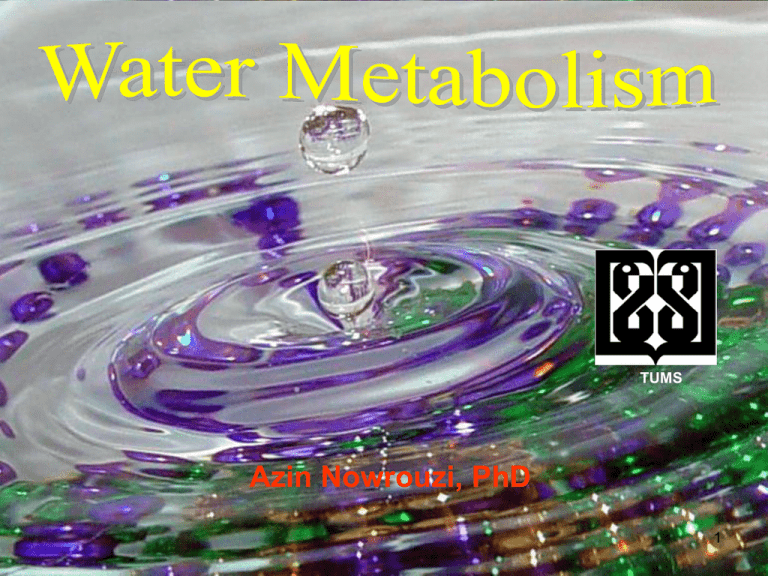
TUMS
Azin Nowrouzi, PhD
1
Principal functions of water
• Universal solvent and suspending medium
• Helps to regulate body temperature
• Participates in hydrolysis reactions
– It is a medium where most cell’s metabolic reactions
take place
• Lubricates organs
• Provides cellular turgidity
• Helps to maintain body homeostasis
– Ionization of water and its acid-base reactions
important for the functions of proteins and nucleic
acids
• The shapes of proteins and nucleic acids and
structure of biological membranes are a
consequence of their interaction with water.
2
Permeability properties
3
Solution Equilibrium
4
Molar distributions
5
Donnan’s Equilibrium
a.
b.
c.
d.
According to Donnan’s equilibrium, the
product of diffusible electrolytes in both
compartments will be equal.
[K+]L x [Cl-]L = [K+]R x [Cl-]R
9 x 4 = 6
x 6
The electrical neutrality in each
compartment is maintained (the number of
anions should equal the number of cations)
In left: K+ = R- + Cl9=5+4
In right: K+ = Cl6=6
Total number of each type of ion is the same
before and after equilibrium
K+ = 9 + 6 = 15
Cl- = 4 + 6 = 10
When there is nondiffusible anion in one
side of a semipermeable membrane, the
diffusible cations are more and diffusible
anions are less, in that side.
Left
Right
(5) K+
(5) Pr -
(10) K+
(10) Cl-
Before equilibrium
Left
Right
(9) K+
(5) Pr (4) Cl-
(6) K+
(6) Cl-
After equilibrium
6
Osmosis &
Osmotic pressure
Osmosis = diffusion of water across a semipermeable
membrane (like a cell membrane) from an area of low solute
concentration to an area of high solute concentration.
7
Cell membrane is a selectively
permeable membrane
8
Osmotically effective solutes
• The major extracellular solute is Na and its
associated anions.
• The major intracellular solute is K and its
associated anions.
• These solutes are relatively restricted to their
compartments
Solutes that are relatively restricted to one
particular body fluid compartment are able to
exert an osmotic force for water movement
from other compartments.
Such solutes are called osmotically effective,
or simply effective solutes.
9
Noneffective solutes
• Some solutes, notably urea pass freely across cell
membranes and do not exert a force for water movement
between the two major body fluid compartments.
• Ethanol, methanol and ethylene glycol are also
noneffective solutes.
• Such noneffective solutes contribute to body osmolality but
not to tonicity.
10
Osmolarity, Osmolality
Osmolarity: Number of particles dissolved in 1 L water
= osm/L H2O
– 1 osmol = 6x1023 solute molecules per liter
– example: 150 mM NaCl = 300 mosmol solute (150
mMNa+ + 150 mM Cl-)
– It is not an SI unit
Volume depends on factors like temperature, thus osmolality is used:
Number of particle in 1kg of water
= osm/kg H2O
For Glucose: molality = osmolality
For NaCl: osmolality = molality x 2
11
Osmolality & osmolarity measurement
• Osmolality can be measured using an
osmometer. Osmometers are useful for
determining the concentration of dissolved salts
or sugars in blood or urine samples.
• Osmolarity = 2 x [Na+] + [urea] + [glucose]
(Concentrations are in mmol/L)
• Difference between the two is osmolar gap. It
occurs when abnormal species are present in
plasma (such as poisons)
12
In medicine
Relative to blood plasma, a
solution can be:
• Isosmolal: Equal osmolality
• Hyposmolal: Lower
osmolality
• Hyperosmolal: Higher
osmolality
Freezing point osmometer
(cryoscope)
13
U-Tube Osmometer
semipermeable membrane (only permeable to water)
direction of net water movement?
14
Tonicity
Tonicity is a unitless concept that can be
expressed only in reference to a physiologic
system:
• A hypertonic solution is one that would
shrink cells.
• A hypotonic one would cause them to swell.
• In an isotonic solution cells are not affected.
• Loss of free water → The fluid becomes too
concentrated (increased osmolarity) → Hypertonic
• Gain in free water → The fluid becomes too dilute
→ It is called Hypotonic
15
Mean concentrations of the more
important solutes in cell compartments
Fluid
Na+
K+
Ca2+
Mg2+
Cl-
Amino
acids
Glucose
mg%
Extracellular
142
4
5
3
103
5
90
Intracellular
10
140
1
58
4
40
0-20
All concentrations except those of glucose are in milliequivalents per liter.
• The osmolality of ECF is in the range of 282-290 mOsm/kg of
water (282-295 mmmol/Kg of water).
• Intracellular fluid osmolality is the same (about 282-290
mOsm/kg water).
– Water freely permeates across cell membranes.
– Major extracellular and intracellular effective solutes do not.
– Any loss or gain of water in the ECF will affect the water
concentration in the ICF.
16
ECF osmolality
Major contributors to ECF osmolality:
• Sodium
• Chloride
• Bicarbonate
• Glucose
• Urea
Osmotically noneffective solutes, such as urea,
contribute to body osmolality but not to tonicity.
17
• Liquid inside cells (Intracellular fluid) - 40 %
• Extracellular fluids - 15 %
• Liquid making the plasma of blood - 5 %
18
Intracellular fluid
35%-40% BW
Total body
water
Blood plasma
(intravascular fluid)
50%-60% BW
4%-5% BW
Extracellular fluid
15%-20% BW
Interstitial fluid
BW = Body Weight
Lymph
(extravascular)
11%-15%BW
Transcellular fluid:
Cerebrospinal fluid
Intraocular fluid
Synovial fluid
Pericardial fluid
Pleural fluid
Peritoneal fluid19
20
Measurement of volumes of the fluid
compartments by
an indirect dilution technique
Compartment Substance used
Total
3H
Extracellular
Thiosulfate, inulin
2O
(radioactive water), antipyrine
Blood plasma Evans blue
Quantity of substance introduced (mg)
Compartment V (ml) = Substance concentration in compartment (mg/ml)
Interstitial fluid = Extracellular fluid – Plasma volume
Intracellular fluid = Total body water – Extracellular fluid volume
21
How does total body water vary?
Age
Infants: Body water ~75%-80% of BW.
Elderly people: Water only 40%-50% of BW.
The percentage decreases with age.
Sex Women usually have less body water than
men because the greater proportion of
adipose tissue in women contains lesser
amounts of water than other tissue types.
Weight Obese people have less body water because
of and abundance of adipose tissue. Total
body water content is inversely related to
body fat content.
Environmental temperature, Physiological state, Food quality and quantity
22
How much water can we lose?
Infants compared to adults
• Body can lose nearly all
fat and over half of its
protein and live.
But
• In adults: Percent body
water is high compared to
the skin surface
– Adults are not very prone to
dehydration.
• 10 -15% loss of water will • Infants are at high risk of
result in death.
dehydration when febrile
• Loss of water through
or lose fluids due to
skin is increased 13% for
vomiting or diarrhea.
each degree rise in
– It is critical to administer
fluids to a febrile infant to
centigrade in body
maintain body homeostasis.
temperature.
23
Sources of body water
1. Drinking water
2. In food
3. Metabolic water from nutrient oxidaton
– Glucose + 6O2 6CO2 + 6H2O
–
1g carbohydreate = 0.6ml water
–
1g protein releases 0.4ml water
–
1g fat generates 1.1ml water
–
About 1000 kcal is equivalent to intake of 125ml of
water
– Alanine + 3O2 2.5 CO2 + CO(NH2)2 + 2.5
H2O
– Palmitic acid + 23O2 16CO2 + 16H2O
24
Water losses
• Urine
– Ambient temperature
– Digestible dry matter
intake
– N intake, metabolism and
excretion
• Feces
– Water intake
– Dry matter intake
– Fiber content of food
• Insensible loss through
evaporation
– Ambient temperature
• Physiological state
– Lactation
– Pregnancy
25
Water balance
Fluid intake = fluid output
Hydration
Positive water balance
When body water intake
exceeds water input
Dehydration
Negative water balance
When water output exceeds
intake
26
Water and salt disturbances
1.
Depletion
–
Water depletion (Dehydration or hypovolemia)
•
•
–
Sodium depletion (Hyponatremia)
• Inadequate oral intake
•
•
2.
Inadequate water intake
Excessive loss
Inadequate parenteral input
Excessive sodium loss (isotonic loss for example in plasma,
hypotonic loss (in sweat or urine)
Excess
–
Water excess (overhydration or hypervolemia)
•
•
–
Impaired excretion
Excessive intake (psychiatric disorders, organic brain disease for
example trauma and following surgery)
Sodium excess (Hypernatremia)
•
•
Increased intake
Decreased excretion (renal disease, primary adrenal disease,
secondary hyperaldosteronism).
27
Dehydration or hypovolemia
(Water loss)
• Causes:
– Decreased intake (lack of water, psychogenic refusal to drink)
– Increased output (vomiting, diarrhea, loss of blood, drainage from
burns, diabetes mellitus, diuretic use, lack of ADH due to diabetes
insipidus.
• Symptoms: loss of weight, rise in body temperature,
increase in heart rate and cardiac output, decrease in blood
pressure, sunken eyeballs.
• Response:
– Decrease in salivary secretion and drying of the mouth and pharynx
thirst
– Increased osmolality and low blood volume and pressure release
of ADH from posterior pituitory, increased reabsorption of water in
kidney tubules
– Aldosterone secretion from adrenal gland
28
Overhydration or hypervolemia
(Water gain)
• Causes:
– Excessive IV administration of fluids, psychogenic
drinking episodes, decreased urinary output because
of renal failure, congestive heart failure
• Symptoms: Decrease in body temperature,
increased blood pressure, edema, weight gain.
• Response:
– Decreased osmolarity of fluids in the hypothalamus
inhibition of thirst, decreased release of ADH and
decreased aldosterone secretion increased urinary
output
29
30
Water intoxication=consumption of too much water too quickly
Hyponatremia (sodium deficit)
Hypernatremia (Sodium excess)
• [Na+] affects plasma & ECF osmolarity
• [Na+] affects blood pressure & ECF
volume
• Normal [Na+] in blood plasma = 150mEq/L
• Excess of water [Na+] below 120 mEq/L
lethargy, coma, or death.
Sodium loss: Decreased ECF volume
Aldosterone secretion Renal sodium
reabsorption decreased Na+ excretion.
31
Too little
aldosterone:
Addison’s disease
Hyperaldosteronism: 1- Primary (due to tumors of adrenal cortex)
2- Secondary: liver disease, heart failure, pregnancy, nephrosis…
32
33
The hormones interact when blood loss
or dehydration occurs to maintain
intravascular volume
a.
b.
c.
d.
Factors that stimulate renin
release:
Decreased blood pressure
Salt depletion
Prostaglandins
Beta-adrenergic drugs
a.
b.
c.
d.
e.
Inhibitors of renin release:
Increased blood pressure
Salt intake
Prostaglandin inhibitors
Beta-adrenergic antagonists
Angiotensin II
34
35
Disturbances in salt and water balance:
Salt & water
Disturbance
ECS
ICS
Osm
Examples
1
Isosmotic
loss
vomiting, diarrhea, diuretic therapy, blood
loss, burn, drainage of ascites
2
Water deficit
ICSECS
sweating, hyperventilation, osmotic diuresis,
chronic renal disease, diabetes insipidus
3
Salt deficit
ECSICS
vomiting, diarrhea, sweating, adrenal
insufficiency, hypokalemia, CNS lesion, saltlosing nephritis.
4
Isosmotic
excess
Heart failure, nephrosis, acute
glomerulonephritis, decompensated cirrhosis
5
Water
excess
ECSICS
Water drinking, excessive ADH secretion,
intensive gastric lavage, infusion of glucose
solution.
6
Salt excess
ICSECS
Infusion of hypertonic saline, adrenal
hyperactivity, steroid therapy, drinking sea
water, CNS lesions
1, 2, and 3 result in hypovolemia
3 and 5 lead to intracellular edema (including cerebral swelling)
4, 5, and 6 result in extracellular edema (for example, pulmonary edema)
36
Clinical conditions regarding Na+
•
Hyponatremia
–
Plasma [Na+] may be normal (if isotonic
loss), high (if hypotonic loss), low (vasopressin
secretion secondary to hypovolemia causes water
retention).
–
Cause:
I. Depletion of sodium (hypovolemic hyponatremia)
II. Water excess (euvolemic hyponatremia)
III. Combined water and sodium excess
(hypervolemic hyponatremia)
•
Hypernatremia
37
38
Water and sodium regulation
1. Through the action of osmoreceptors in the hypothalamus,
and baroreceptors (stretch receptors) in atria.
– Antidiuretic Hormone (ADH) (vasopressin)
•
Increases the water permeability of the distal tubule and collecting duct,
thus increasing the concentration of urine.
– Atrial Natriuretic Peptide (ANP)
•
Released when atrial pressure is increased e.g. in heart failure or fluid
overload. It promotes loss of sodium and chloride ions and water
chiefly by increasing GFR.
2. NaCl content of body determines the size of extracellular
fluid.
– Renin
•
•
Increases the production of angiotensin II
Released when there is a fall in intravascular volume e.g. haemorrhage
and dehydration
– Aldosterone
•
Promotes sodium ion and water reabsorption in the distal tubule and
collecting duct where Na+ is exchanged for potassium (K+) and
hydrogen ions by a specific cellular pump
39
Role of the Kidney
• GFR = Volume of filtrate formed by all the nephrons of
both kidneys each minute.
– In adult female GFR = 110 ml/min
– In male, GFR = 125 ml/min
• Thus a volume of 7.5 L/h, or 180 L/day is formed.
– ~99% of the filtrate is reabsorbed from renal tubules and
returned to the bloodstream.
– ~1% is excreted in urine
• Urine volume is regulated according to the needs of the
body.
• Most solutes are reabsorbed completely or almost
completely according to the needs of the body.
40
Renal handling of different substances
Substance
Water
Glucose
Sodium
Urea
Kg/day
filtered
180.00
0.180
0.630
0.056
Kg/day
excreted
1.8
0.180
0.0032
0.028
Percentage
reabsorbed
99%
100%
99.5%
50%
• Substances that are actively transported from peritubular
capillaries to the tubule lumen:
Hydrogen, potassium, penicillin, poisons, drugs,
metabolic toxins, chemicals that are not normally present
in the body.
41
Nephron segment
• Proximal tubule
• Distal tubule
– Glucose & Na+
– Na+ & H2O
• Loop of Henle
– H2O, Na+, K+ & Cl-
• Collecting duct
– H2O, Na+ & urea
– Hormone regulated
42
43
Regulation of Urine Concentration by the kidneys
44
Countercurrent multiplier exchange
45
Diabetic Hyperosmolar state
• In diabetics with serum glucose ~ 700 mg/dL,
the hyperosmolar state caused efflux of cellular
water osmotic dilution of serum sodium.
(For each 100 mg/dL increase in serum glucose,
there is 1.6 mEq/L decrease in the serum [Na+]).
• Transport of glucose into cells happens along
with concurrent potassium transport into cells
insulin resistance causes high serum potassium.
• Pattern:
• Low serum sodium and high serum potassium
(same as hypoaldosteronism),
• High glucose levels.
46
Drugs affecting water absorption in kidney
tubules: Diuretics & Antidiuretics
•
•
•
•
•
Diuretic drugs:
Act on nephronic
tubules
Increase the excretion
of salt (NaCl, NaHCO3)
and water.
used in heart failure
management
BP control
reduction of edema
correction of base-acid
balance (pH)
Antidiuretic drugs:
Decrease the
secretion of salt and
water.
47
Free Water Passing Through Membrane Pores
48
Cellular Mechanisms of Water Transport
• The precise pathways whereby water
crosses membranes has only recently
been discovered.
• A family of membrane proteins has now
been described, termed aquaporins.
• To date three members of this family have
been described in mammals and are
termed CHIP28, WCH-CD and MIP26 and
display about 45% homology.
49
Water channel molecules
• CHIP28 (channel forming integral protein) was the first
known water channel molecule.
– A 28 kDa protein, and within the kidney is found exclusively in
the proximal tubule.
– CHIP28 protein is present in many tissues including lung, small
intestine, and red blood cells, and therefore plays an important
role in water transport in different organs
• WCH-CD (water channel of the collecting duct)
– Found exclusively in the collecting duct, on the luminal surface of
the tubule, and is sensitive to ADH (whereas CHIP28 is not).
• MIP26 (major intrinsic protein of the mammalian lens)
has not been detected in renal tissue.
50
Formation of Water Pores:
Mechanism of Vasopressin Action
51
Potassium inside the kidney
52

